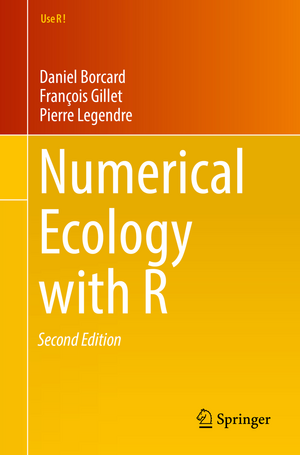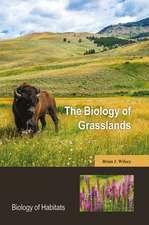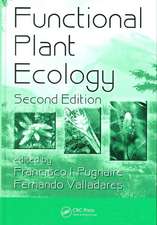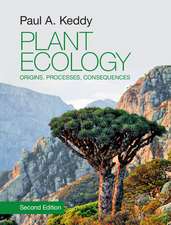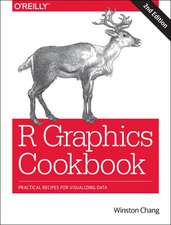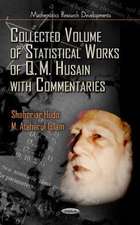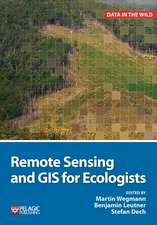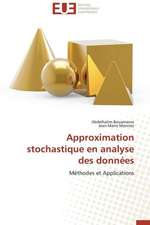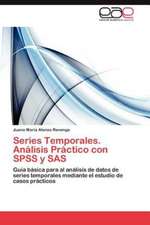Numerical Ecology with R: Use R!
Autor Daniel Borcard, François Gillet, Pierre Legendreen Limba Engleză Paperback – 3 apr 2018
This book is aimed at professional researchers, practitioners, graduate students and teachers in ecology, environmental science and engineering, and in related fields such as oceanography, molecular ecology, agriculture and soil science, who already have a background in general and multivariate statistics and wish to apply this knowledge to their data using the R language, as well as people willing to accompany their disciplinary learning with practical applications. People from other fields (e.g. geology, geography, paleoecology, phylogenetics, anthropology, the social and education sciences, etc.) may also benefit from the materials presented in this book. Users are invited to use this book as a teaching companion at the computer. All the necessary data files, the scripts used in the chapters, as well as extra R functions and packages written by the authors of the book, are available online (URL: http://adn.biol.umontreal.ca/~numericalecology/numecolR/).
Din seria Use R!
- 15%
 Preț: 676.86 lei
Preț: 676.86 lei - 17%
 Preț: 362.75 lei
Preț: 362.75 lei - 15%
 Preț: 591.79 lei
Preț: 591.79 lei - 17%
 Preț: 362.16 lei
Preț: 362.16 lei - 17%
 Preț: 461.37 lei
Preț: 461.37 lei -
 Preț: 226.74 lei
Preț: 226.74 lei - 17%
 Preț: 395.94 lei
Preț: 395.94 lei -
 Preț: 374.87 lei
Preț: 374.87 lei - 20%
 Preț: 500.66 lei
Preț: 500.66 lei - 17%
 Preț: 396.92 lei
Preț: 396.92 lei - 15%
 Preț: 360.59 lei
Preț: 360.59 lei - 17%
 Preț: 430.21 lei
Preț: 430.21 lei -
 Preț: 276.09 lei
Preț: 276.09 lei - 15%
 Preț: 497.12 lei
Preț: 497.12 lei - 15%
 Preț: 471.53 lei
Preț: 471.53 lei - 15%
 Preț: 525.35 lei
Preț: 525.35 lei -
 Preț: 489.30 lei
Preț: 489.30 lei - 15%
 Preț: 523.07 lei
Preț: 523.07 lei -
 Preț: 455.89 lei
Preț: 455.89 lei - 15%
 Preț: 518.73 lei
Preț: 518.73 lei - 18%
 Preț: 835.24 lei
Preț: 835.24 lei - 15%
 Preț: 498.94 lei
Preț: 498.94 lei - 18%
 Preț: 783.35 lei
Preț: 783.35 lei - 18%
 Preț: 783.20 lei
Preț: 783.20 lei - 15%
 Preț: 523.91 lei
Preț: 523.91 lei -
 Preț: 484.47 lei
Preț: 484.47 lei -
 Preț: 420.40 lei
Preț: 420.40 lei - 15%
 Preț: 523.07 lei
Preț: 523.07 lei -
 Preț: 419.06 lei
Preț: 419.06 lei - 15%
 Preț: 695.70 lei
Preț: 695.70 lei - 15%
 Preț: 499.12 lei
Preț: 499.12 lei - 15%
 Preț: 493.89 lei
Preț: 493.89 lei - 15%
 Preț: 584.10 lei
Preț: 584.10 lei - 15%
 Preț: 497.31 lei
Preț: 497.31 lei - 15%
 Preț: 696.02 lei
Preț: 696.02 lei -
 Preț: 420.02 lei
Preț: 420.02 lei -
 Preț: 489.87 lei
Preț: 489.87 lei - 15%
 Preț: 579.66 lei
Preț: 579.66 lei -
 Preț: 486.42 lei
Preț: 486.42 lei - 15%
 Preț: 507.95 lei
Preț: 507.95 lei -
 Preț: 388.34 lei
Preț: 388.34 lei - 15%
 Preț: 496.67 lei
Preț: 496.67 lei -
 Preț: 423.47 lei
Preț: 423.47 lei - 15%
 Preț: 520.61 lei
Preț: 520.61 lei - 15%
 Preț: 531.26 lei
Preț: 531.26 lei - 15%
 Preț: 576.52 lei
Preț: 576.52 lei -
 Preț: 454.16 lei
Preț: 454.16 lei
Preț: 591.47 lei
Preț vechi: 695.84 lei
-15% Nou
Puncte Express: 887
Preț estimativ în valută:
113.21€ • 123.02$ • 95.16£
113.21€ • 123.02$ • 95.16£
Carte tipărită la comandă
Livrare economică 21 aprilie-05 mai
Preluare comenzi: 021 569.72.76
Specificații
ISBN-13: 9783319714035
ISBN-10: 3319714031
Pagini: 440
Ilustrații: XV, 435 p. 657 illus., 633 illus. in color.
Dimensiuni: 155 x 235 x 28 mm
Greutate: 0.63 kg
Ediția:2nd ed. 2018
Editura: Springer International Publishing
Colecția Springer
Seria Use R!
Locul publicării:Cham, Switzerland
ISBN-10: 3319714031
Pagini: 440
Ilustrații: XV, 435 p. 657 illus., 633 illus. in color.
Dimensiuni: 155 x 235 x 28 mm
Greutate: 0.63 kg
Ediția:2nd ed. 2018
Editura: Springer International Publishing
Colecția Springer
Seria Use R!
Locul publicării:Cham, Switzerland
Cuprins
Chapter 1. Introduction.- Chapter 2. Exploratory Data Analysis.- Chapter 3. Association Measures and Matrices.- Chapter 4. Cluster Analysis.- Chapter 5. Unconstrained Ordination.- Chapter 6. Canonical Ordination.- Chapter 7. Spatial Analysis of Ecological Data.- Chapter 8. Community Diversity.
Notă biografică
Daniel Borcard is lecturer of Biostatistics and Ecology and researcher in Numerical Ecology at Université de Montréal, Québec, Canada. His research interests include Numerical Ecology, Ecology of communities, and Soil Ecology/Zoology.
François Gillet is professor of Community Ecology and Ecological Modelling at Université Bourgogne Franche-Comté, Besançon, France, and visiting professor at École Polytechnique Fédérale de Lausanne, Switzerland. His research deals with the structure, diversity, ecology and dynamics of plant communities.
Pierre Legendre is professor of Quantitative Biology and Ecology at Université de Montréal, fellow of the Royal Society of Canada, and Web of Science Highly Cited Researcher in Environment/Ecology. He is the founder of the field of numerical ecology.
François Gillet is professor of Community Ecology and Ecological Modelling at Université Bourgogne Franche-Comté, Besançon, France, and visiting professor at École Polytechnique Fédérale de Lausanne, Switzerland. His research deals with the structure, diversity, ecology and dynamics of plant communities.
Pierre Legendre is professor of Quantitative Biology and Ecology at Université de Montréal, fellow of the Royal Society of Canada, and Web of Science Highly Cited Researcher in Environment/Ecology. He is the founder of the field of numerical ecology.
Textul de pe ultima copertă
This new edition of Numerical Ecology with R guides readers through an applied exploration of the major methods of multivariate data analysis, as seen through the eyes of three ecologists. It provides a bridge between a textbook of numerical ecology and the implementation of this discipline in the R language. The book begins by examining some exploratory approaches. It proceeds logically with the construction of the key building blocks of most methods, i.e. association measures and matrices, and then submits example data to three families of approaches: clustering, ordination and canonical ordination. The last two chapters make use of these methods to explore important and contemporary issues in ecology: the analysis of spatial structures and of community diversity. The aims of methods thus range from descriptive to explanatory and predictive and encompass a wide variety of approaches that should provide readers with an extensive toolbox that can address a wide palette of questions arising in contemporary multivariate ecological analysis. The second edition of this book features a complete revision to the R code and offers improved procedures and more diverse applications of the major methods. It also highlights important changes in the methods and expands upon topics such as multiple correspondence analysis, principal response curves and co-correspondence analysis. New features include the study of relationships between species traits and the environment, and community diversity analysis.
This book is aimed at professional researchers, practitioners, graduate students and teachers in ecology, environmental science and engineering, and in related fields such as oceanography, molecular ecology, agriculture and soil science, who already have a background in general and multivariate statistics and wish to apply this knowledge to their data using the R language, as well as people willing to accompany their disciplinary learning with practical applications. People from other fields (e.g. geology, geography, paleoecology, phylogenetics, anthropology, the social and education sciences, etc.) may also benefit from the materials presented in this book. Users are invited to use this book as a teaching companion at the computer. All the necessary data files, the scripts used in the chapters, as well as extra R functions and packages written by the authors of the book, are available online (URL: http://adn.biol.umontreal.ca/~numericalecology/numecolR/).
This book is aimed at professional researchers, practitioners, graduate students and teachers in ecology, environmental science and engineering, and in related fields such as oceanography, molecular ecology, agriculture and soil science, who already have a background in general and multivariate statistics and wish to apply this knowledge to their data using the R language, as well as people willing to accompany their disciplinary learning with practical applications. People from other fields (e.g. geology, geography, paleoecology, phylogenetics, anthropology, the social and education sciences, etc.) may also benefit from the materials presented in this book. Users are invited to use this book as a teaching companion at the computer. All the necessary data files, the scripts used in the chapters, as well as extra R functions and packages written by the authors of the book, are available online (URL: http://adn.biol.umontreal.ca/~numericalecology/numecolR/).
Caracteristici
Offers an up-to-date, practical guide to numerical ecology from leaders in the field Provides complete data sets, functions and scripts Includes examples with extensive commentaries
